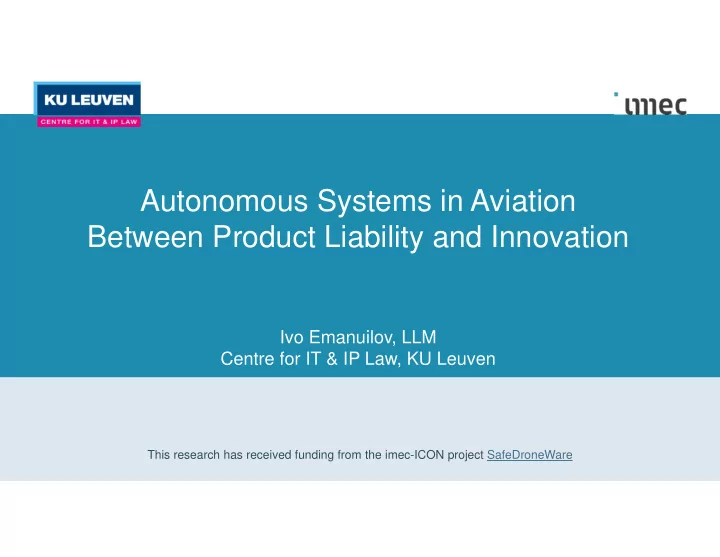

Autonomous Systems in Aviation Between Product Liability and Innovation Ivo Emanuilov, LLM Centre for IT & IP Law, KU Leuven This research has received funding from the imec-ICON project SafeDroneWare
2 Who am I?
Centre for IT & IP Law • Research centre at the Faculty of Law of KU Leuven • More than 40 researchers specialised in legal and ethical aspects of IT innovation and intellectual property • Solid track record as a law and ethics partner of large international and interdisciplinary research projects • Internationally renowned for its expertise in the areas of data protection and privacy, health and care, intellectual property, media and communications, and (cyber)security 3
Why bother? Strive for innovation Strive for innovation • From automation to autonomy • Increasingly autonomous cyber-physical systems • (Self-)adaptive software relying on machine learning, AI... • Cyber (rules of code) v Physical (linear rules) Conservatism 4
Software fails... • Überlingen mid-air collision • Ariane 5 maiden flight • Boeing 787 Dreamliner reboot problem 5
What about (self-)adaptive software? 6
From adaptation to evolution Evolution (New) ‘Unknown behaviour unknowns’ Dynamic Adaptation resources Uncertainty ‘Known unknowns’ 7
Why are manufacturers at risk? • Product liability = liability for a ‘defect’ in a ‘product’ • Strict liability : no fault is required; only defect + damages • Target : producers/manufacturers (broadly) • Limits : unlimited • Claimants : injured parties • Product : “movables” (broadly), but what about software? Also documentation, instructions etc. • Defect : failure to meet “a person’s legitimate safety expectations ”, ie general public… so: a product may be technically fine, but may still fail to meet the legitimate expectations of safety 8
From pacemakers to aviation systems… • Question: does the product liability regime apply to cases where a specific product has not yet shown any defects, nor caused any damages, provided that the group to which it belongs shows a tendency of a specific defect? • “ […] where it is found that such products belonging to the same group or forming part of the same production series have a potential defect, it is possible to classify as defective all the products in that group or series, without there being any need to show that the product in question is defective. ” (§ 41, Judgment of the Court, Joined Cases C-503/13 and C-504/13) • In the case: “ abnormal potential for damage ” is a leading criterion 9
Liability for ‘potential’ defects? Risk of malfunctioning becoming a defect in the future State of the art Manufacturer statements Product P1 ‘put ‘Potential’ presentation into defect in circulation’ P1? Subsequent information? P2 ‘put into circulation’ (better) Legitimate safety expectations Excluded! 10
Defences (1) + manufacturers must prove they could “objective state of scientific and not have known about the risk of product technical knowledge” does not allow malfunctioning becoming a defect in the for the defect to be discovered future Development risk defence for defects Development risk defence for potential defects (‘state of the art’ defence) (‘state of the art’ defence) • Very high exoneration standard • Negligence ‘twist’ strict liability? • Raising an alert in itself influences the public’s safety expectations = deterrence? 11
Defences (2) • Regulatory compliance defence: if defect is “ due to compliance of the product with mandatory regulations issued by the public authorities ” – 2 conditions: • Mandatory requirements • Diverging interpretations but generally construed restrictively: Must not leave margin for appreciation (cf Überlingen (Manufacturers) ) • Standards not mandatory, but non-compliance may indicate failure to meet legitimate safety expectations • Defect is the result of compliance with these requirements • Challenges for regulators and certification bodies: how to certify ‘autonomous behaviour’? Will it be precise enough to cover newly learnt behaviour? • Liability of standard-setters and regulators for design choices in standards etc.? 12
Dare to innovate? • Expected review of Product Liability Directive • Statutory clarification and objective criteria for concepts such as ‘abnormal potential for damage’, ‘potential defect’ etc. • Clarify applicability of state of the art defence to autonomous systems • More explicit liability rules for standard-setters and regulators
“We cannot solve our problems with the same thinking we used when we created them.” Albert Einstein 14
Thank you for your attention! 15
KU Leuven Centre for IT & IP Law (CiTiP) - imec Sint-Michielsstraat 6, box 3443 BE-3000 Leuven, Belgium http://www.law.kuleuven.be/citip ivo.emanuilov@kuleuven.be https://ivoatlaw.com 16
Recommend
More recommend